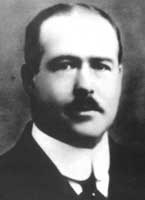Walter Sutton facts for kids
Quick facts for kids
Walter Sutton
|
|
|---|---|
 |
|
| Born | April 5, 1877 |
| Died | November 10, 1916 (aged 39) |
| Alma mater | University of Kansas Columbia University |
| Known for | Boveri–Sutton chromosome theory Surgical improvements |
| Scientific career | |
| Fields | Genetics, medicine |
| Doctoral advisor | Edmund B. Wilson |
Walter Stanborough Sutton (born April 5, 1877 – died November 10, 1916) was an American scientist. He was a biologist and a geneticist. His most important idea was about how traits are passed down. He suggested that Mendel's rules for how traits are inherited could be seen in chromosomes inside living cells. This big idea is now called the Boveri–Sutton chromosome theory.
Contents
Walter Sutton's Early Life
Walter Sutton was born in Utica, New York. He grew up on a farm in Russell, Kansas. He was the fifth of seven sons. On the farm, he learned how to fix machines. This skill helped him later when he worked with oil drilling equipment and medical tools.
Studying at the University of Kansas
After high school, Walter started studying engineering at the University of Kansas in 1896. Sadly, his younger brother died from typhus in 1897. After this, Walter changed his studies to biology. He became very interested in medicine.
While at the University of Kansas, Walter and his older brother, William, played basketball. Their coach was Dr. James Naismith, who invented basketball! Walter was a great student. He earned both his bachelor's and master's degrees by 1901. For his master's project, he studied the cells of a large grasshopper.
Research at Columbia University
Walter's teacher at the University of Kansas, Dr. C. E. McClung, told him to study more. So, Walter went to Columbia University to learn more about zoology. There, he worked with Dr. Edmund B. Wilson.
At Columbia, Walter wrote his two most important papers about genetics. In these papers, he explained how chromosomes carry genetic information. He could now explain "why the yellow dog is yellow."
A German biologist named Theodor Boveri came up with similar ideas on his own. Because of this, their ideas are often called the Boveri–Sutton chromosome theory. Most scientists, especially those who studied cells, quickly accepted Sutton's idea. Later, Thomas Hunt Morgan at Columbia proved the theory even more. He did this by studying Drosophila melanogaster, which are fruit flies.
Walter Sutton did not finish his PhD in zoology right away. When he was 26, he went back to work in the oil fields in Kansas for two years. There, he improved machines for starting large gas engines. He also developed equipment for lifting things from deep wells. His mechanical skills were always useful! His father eventually told him to go back to medical school. So, Walter returned to Columbia University in 1905.
Walter studied medicine at the College of Physicians and Surgeons at Columbia. He kept working on inventions for oil drilling. But he also started using his mechanical skills to make medical tools better. He earned his medical degree in 1907 with "high standing." Then, he started working as an intern at Roosevelt Hospital in New York. He worked in the surgery department.
Walter Sutton's Medical Career
Besides his work at Roosevelt Hospital, Walter also worked in the Surgical Research Laboratory at the College of Physicians and Surgeons. With their help, he improved many medical and surgical methods. This included making anesthetic techniques better and improving how doctors cleaned inside the body during surgery.
In 1909, Walter Sutton moved back to Kansas City, Kansas. His family had moved there. He became an assistant professor of surgery at the University of Kansas Medical School. He also had his own private medical practice. He worked at St. Margaret's Hospital and the university's Bell Memorial Hospital. For six years, Walter performed many different surgeries. He carefully wrote down what he did. He published several articles about his cases.
In 1911, he joined the United States Army Medical Reserve Corps as a First Lieutenant. This led him to take time off from the university in February 1915. He went to serve at the American Ambulance Hospital near Paris, France. Walter and other doctors arrived at College of Juilly on February 23. The hospital was only 40 miles from the front lines of World War I.
Within two months, he became the chief surgeon. He managed the hospital and performed surgeries. His inventing skills were very important here. He developed ways to use X-rays to find metal pieces inside soldiers' bodies. Then, he removed these pieces using tools he designed himself. After he returned home, he wrote about these techniques in a medical book. Walter Sutton sailed back from France on June 26, 1915. He had only stayed for four months, but he made a huge difference in wartime medical care.
Sadly, Dr. Sutton died unexpectedly at age 39. He had problems from a sudden case of appendicitis.
Images for kids
See also
 In Spanish: Walter Sutton para niños
In Spanish: Walter Sutton para niños


